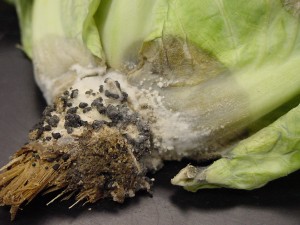White mold, or lettuce drop, caused by Sclerotinia sclerotiorum, can cause serious losses in lettuce and other susceptible crops if left uncontrolled. Disease development is favored by wet, humid conditions (especially in high tunnels and fields) with known histories of the disease.

White mold on lettuce. Notice the white fungal growth and black sclerotia developing on the base of the stem. The sclerotia can survive in the soil for up to 10 years.
The sclerotia of the fungus can survive for up many years in the soil once fields or high tunnels become infested. Infected plants typically show symptoms soon after transplanting or as plants reach maturity when entire plants will wilt and collapse very quickly. In cool, wet soils the fungus will infect the host and produce the characteristic white fungal growth on stems of infected plants, eventually black sclerotia will develop. Control of white mold begins with preventative fungicide applications soon after transplanting, removing infected plants to remove the sclerotia. Growers should keep planting beds as dry as possible. A level planting bed is desired because this will help evenly distribute water. Irrigate in the morning which promotes drying of the soil surface and foliage. Avoid excess fertilization with nitrogen which promotes excessive foliar growth and a dense canopy.
For lettuce: Apply one of the following fungicides at transplanting and/or thinning (see labels for instruction): Cannonball (fludioxonil, 12) at 7.0 oz. 40WP/A; iprodione at 1.5 to 2.0 lb 50WP/A (2 applications per season allowed); Endura (boscalid, 7) at 8.0 to 11.0 oz. 70WP/A (suppression only, 2 applications only); Quadris (azoxystrobin, 11) at 0.40 to 0.80 fl oz./100 0 ft row 2.08F.
For cabbage and related crops: Apply Endura (boscalid, 7) at 6.0 to 9.0 oz 70WG/A (only 2 applications per season), or Fontelis (penthiopyrad, 7) at 16.0 to 30.0 fl oz. 1.67SC/A.
For more information on the control of white mold in high tunnels and in the field, please see Table E-11 and specific crop sections in the 2024/2025 Commercial Vegetable Production Recommendations Guide.

